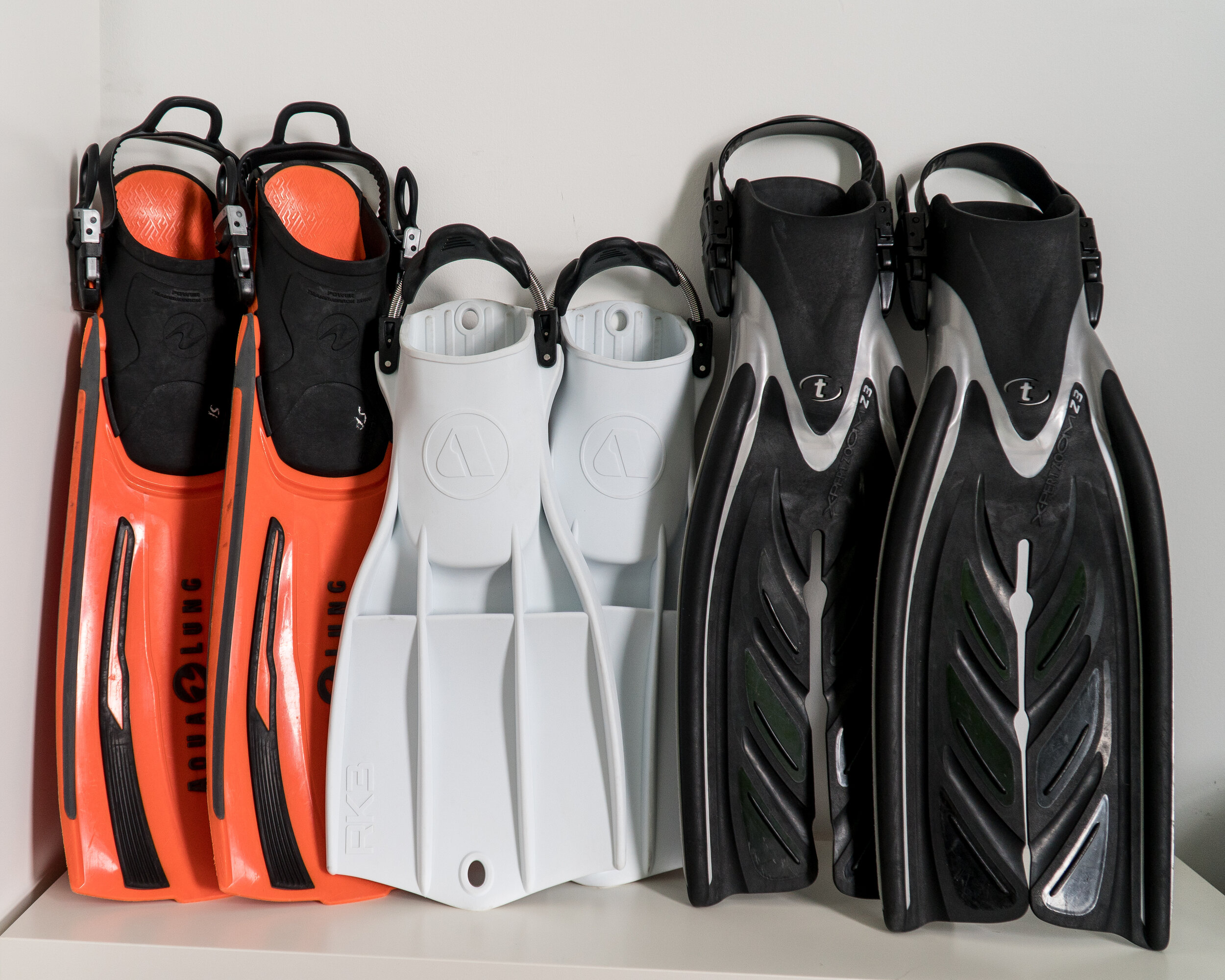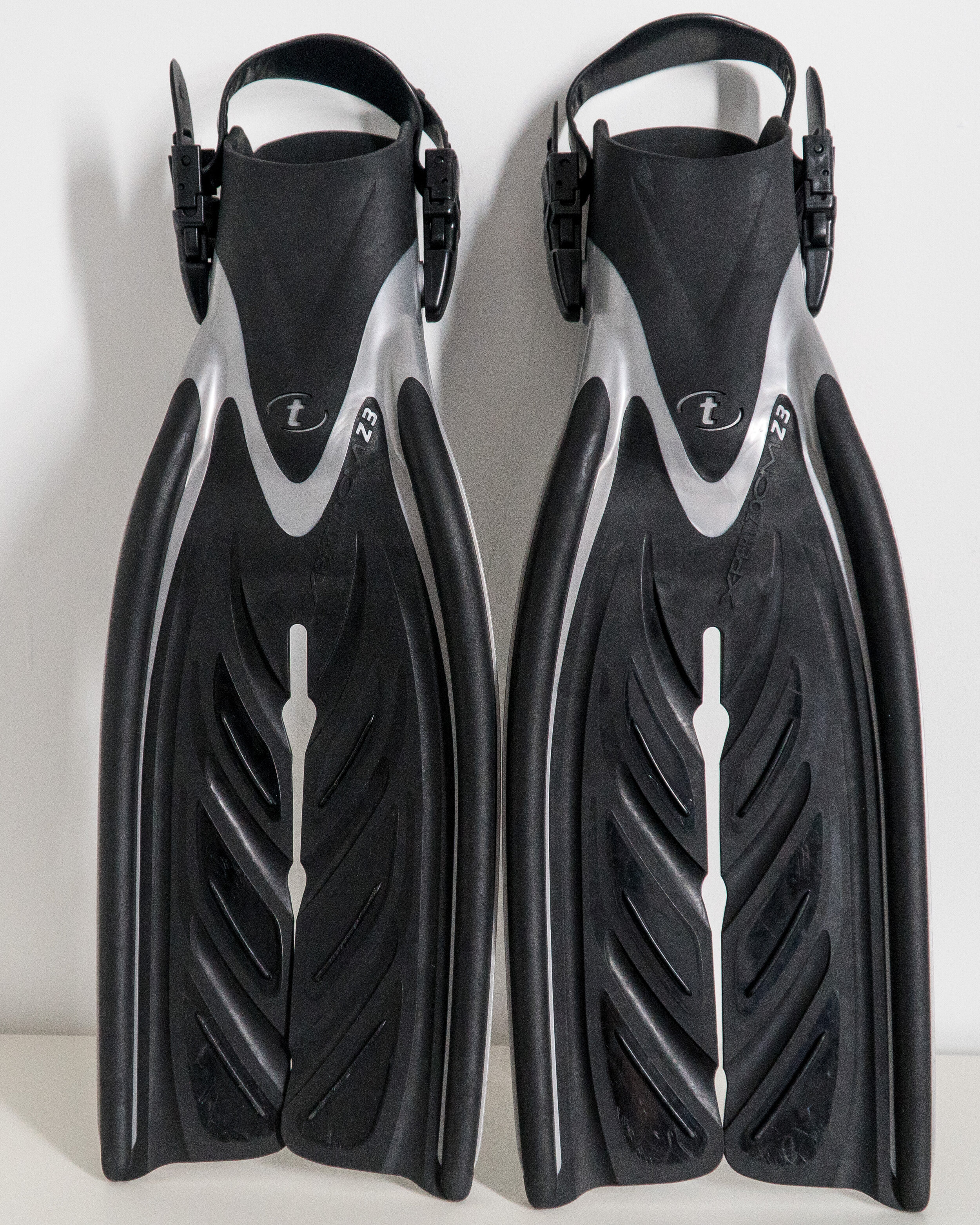Dive Essentials - Fins
Along with your mask, fins are the item of scuba equipment that you are most likely to buy for yourself as they are affordable and its really important to get the right fins for you. But, choosing the right fin for you is an increasingly difficult task as the range of styles and types of fin seems to be expanding at an almost exponential rate. Luckily we are here to help explain a few tips for choosing the right fins for you and also explain a bit about the different styles and what they are used for.
A variety fins styles from the classic blade fin on the left, vented fins in the centre and split fins on the right
Believe it or not, it is possible to dive without fins, especially if you wish to entertain your fellow divers and use your air up super quick, however like many things that are possible its not always a good idea. To be able to move through the water efficiently, not scare off fish and not waste air fins (not flippers!) were invented, but how do you choose the right fins for you? Do you go with simple full foot fins or fancy open heel split fins? What are the advantages and disadvantages for each type?
Over the years fins have evolved from simple origins into a wide array of types and styles each designed to suit differing styles and conditions which the diver may encounter. While it may seem that they are quite simple pieces of plastic attached to your foot the amount of technology now involved is quite surprising and getting the wrong style for you can mean that you feel uncomfortable, not a ease and thus don’t have a particularly enjoyable experience and potentially use your air supply up at an alarming rate. As with most diving equipment it comfort is the number one factor and should be the main guiding principle and as with masks always ensure you try before you buy to ensure you are happy with your purchase.
Open Heel Vs Full Foot:
Often the first choice you will need to make is whether or not to go with “open heel” fins which as the name suggests have an open heel with an adjustable strap or spring or go for “full foot” fins which have a foot pocket that allows you to slip it on over the foot. Each style has its own pro and cons, “full foot” fins are often used for snorkelling and warm water diving and are often lighter and don’t require a boot. This is advantage when travelling as it saves on valuable space and weight ion your luggage but this comes at the expense of choice and power as the blades are often smaller when compared to “open heel fins. “Open heel” fins offer a wider variety of styles when compared to the full foot versions but are heavier and do require the use of boots to ensure comfort. This is n advantage when diving in colder water, but when travelling this can consume those precious kilograms of baggage allowance. My personal preference is for “open heel” fins as they offer a wider variety of styles and I like to use a boot as it is often more comfortable when entering the water via a beach or walking to and from the boat.
Aqualung Stratos Adj fins - an example of the classic blade/paddle fin
Split vs Blade Fins:
With many styles of blade available you need to have a think about what type of diving you will be doing most often and then select your blade, unless you are willing to have a number of different types of fins and choose based on what you know you’ll be doing. Traditional blade fins such as the ones shown above are a great all round option, firm enough to dive in moderate current, light enough to travel with and great for the flutter kick you can’t really go wrong with them. However, they aren’t the most economical of fins and can reduce your bottom time by making you work harder and thus use up your air quicker. One way to avoid this problem is to use split fins which are generally more efficient in calm waters, however they remain a slightly controversial choice amongst scuba divers due to their lack of power in current which some claim can put the user and others at risk. Personally I feel as long as you do your research and use them responsibly (i.e don’t try diving Komodo in split fins!) then you will be perfectly safe, they also have an added benefit of being gentler on joints and knees and for those who are prone to cramp they are especially suitable. They suit the flutter kick best, trying a frog kick with them won’t be so successful and you’ll end up looking a bit silly and going nowhere quite quickly.
Another option are vented fins which are often wider and shorter than split or blade fins and lend themselves well to the frog kick. Favoured by tech divers they are also a great choice for recreational divers as well due to their size which often helps with travel and fitting everything inside your luggage. Some often come with spring straps which are great are they are durable and easy to put on and take off, especially on crowded boats.
Apeks RK3 vented fins - often favoured by the military and also technical divers
Travel vs Durability:
Travelling to dive can mean that you need to compromise on the equipment you take with you as often you are limited by baggage allowances and space, so taking a range of different fins styles is not often possible. Often a blade or vented fin is best when travelling further afield as they are more of an all-round fin and offer greater performance in unexpected currents. The ultimate travel fin is probably a “full foot” fin as they are light and take up less space with no need for booties or socks.
Tusa Z-pert Z3 split fins - a great choice for efficiency and reducing stress on knees
Getting the Right Fit:
Ill fitting fins are a pain, we have all had a dive where we can’t get comfortable with our fins, the foot rubs on the locket and we come out of the water with blisters or sore feet. But, by following a few simple steps you can ensure that you don’t have these problems again:
Always try before you buy - buying straight from the internet may seem tempting especially with big discounts available but you are putting yourself at the mercy of the gods.
If you are buying “open heel” fins take your dive boot with you, its important that you try on the fins as you would when you dive.
Sit down and put the fin on. It should be a snug fit if buying “full foot” closed heel fins, if buying “open heel” then you should see a few inches of your heel sticking out of the back of the pocket.
Move your feet around to make sure its a good fit and are tight, but don’t rub and that your feet don’t move about in the pocket. You don’t want blisters at the end of your dive, or even worse and find coming off mid dive!
Hopefully by following these simple steps you’ll be able to find the right fit and fins for you - the right style of fin combined with the right fit can have a lasting impact on your diving for many years, in the best case you forget all about your fins during the dive and can concentrate on the beauty of the underwater world around you. Happy finning!



